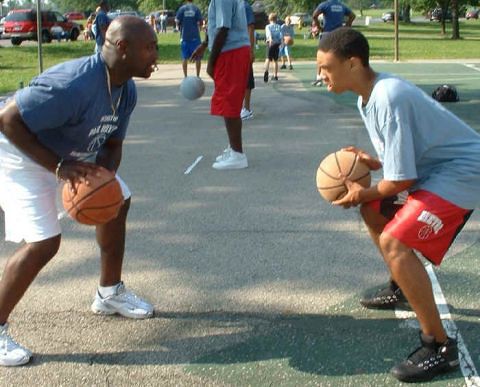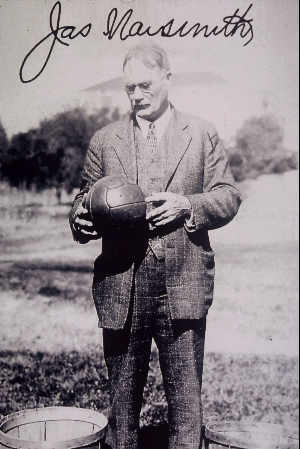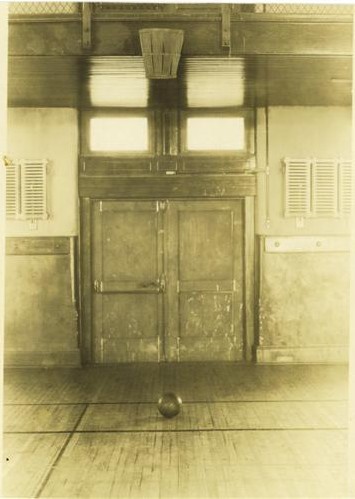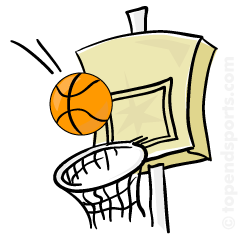Wednesday, July 18, 2007
I am out of here.
If you really want to learn about basketball here are two of the best sites that I use as my referance. They have almost all that a coach can teach you...
http://www.guidetocoachingbasketball.com/
http://www.basketball-plays-and-tips.com/
Sunday, July 15, 2007
Rules regarding Stopping and Traveling
a. If both feet are off the floor and the player lands;
(1) Simultaneously on both feet, either foot may be the pivot.
b. If one foot is on the floor;
(1) It is the pivot when the other foot touches in a step.
a. The pivot foot may be lifted, but not returned to the floor, before the ball is released on a pass or try for goal;
How to Stop?
One-two step landing
When doing this landing (after a sprint or speed dribble), one foot lands first (the back foot) and then the second foot lands. The back foot becomes the pivot foot. When stopping, let the second foot to land extend wide from the back foot for better balance.
Jump-stop
When doing the jump-stop, both feet land simultaneously. The last step should be a hop and when you land, have your weight leaning backward a little to help slow your momentum. Using this stop, you are now free to use either foot as your pivot foot.
There is confusion over the rules and what is legal and what constitutes a traveling violation. My interpretation is this... it depends on whether you already have possession of the ball or not (as in receiving a pass), and whether or not you have already used up the one-step that you are entitled to. When receiving a pass with a jump-stop, you can pivot after the jump-stop and either foot can become the pivot foot. This is especially helpful for post players. A perimeter player can catch the ball with a jump-stop, and the pivot into triple-threat position if necessary and use the non-pivot foot for executing jab-step fakes or a drive step.
Now let's take a player who already has possession of the ball on the outside. He/she makes a dribble move into the lane, picks up the dribble, takes one step, and then lands a two-footed jump-stop. So far, so good. But after landing the jump-stop, he/she cannot move either foot and has no pivot foot since the one step was already used up prior to the jump-stop. He/she could jump upward, but must either shoot or pass the ball before either foot touches the floor again.
Pivoting
In a forward pivot, the player pivots forward, while in a reverse pivot, the player pivots backward. For example, let's say the left foot is the pivot foot (usually the case for a right-handed player). Here, a forward pivot would have the player pivoting (spinning), or stepping forward in a counterclockwise motion (if looking down from above). A reverse pivot would have the player pivoting, or stepping backwards (drop-stepping) in a clockwise motion. Just the opposite would be the case if the right foot were the pivot foot.
Which foot should be my pivot foot?
You must be able to pivot forward and backward using either foot.
Pivoting drills
1. Start with the left foot as pivot foot. Pivot forward 15 times.
Pivoting Pointers
1. You must keep your head up with eyes forward.
Triple Threat Position
- Stand with your feet shoulder-width apart.
- Stagger your feet slightly, so that your left foot points into the arch of your right foot.
- Bend your knees and crouch slightly.
- Grasp the ball with your left hand on the side of the ball and your right hand on top.
- Bend both elbows so they're approximately at right angles.
- Survey the court at all times.
- Decide what the most appropriate maneuver for your current situation is.
Tips.
- You want to be comfortable when you're in the triple threat position.
- If you get into the triple threat position every time you receive the ball, you don't waste excess movements deciding what to do.
- Having three options makes it more difficult for the defender to figure out what your next move will be.
Illustration:

Offensive Stance
Basketball Fundamentals - Footwork
Rules: As short as they can be.
- There are five players from each team on the court at any one time, with up to five substitutes sitting on the side line.
- The game begins with the ball being thrown up by the referee. Two players, standing in the center circle, jump for it and try to tap it to one of their team mates.
- Players pass the ball to one another, or run with the ball while bouncing it on the ground.
The aim of the game is to throw the ball through the hoop. - Two points are awarded for each successful throw, except for throws from outside the three point line (3 points), or for penalty free throws (one point).
- No holding, tripping, hitting or pushing is allowed. Referees control the game. If a player commits more than five fouls, they are sent off the court for the remainder of the game.
- The ball is round with a circumference of 75-78 cm, and weighs 600-650 grams.
Little Bit of History
 Dr. James Naismith
Dr. James NaismithNaismith's handwritten diaries, discovered by his granddaughter in Spring 2006, indicate that he was nervous about the new game he had invented, which incorporated rules from a Canadian children's game called "Duck on a Rock", as many had failed before it. Naismith called the new game 'Basket Ball'.

Seriously
It’s time to get rid of posting arbitrary articles in no pattern and start doing something that is sensible and really helps; night outs and getting up late in the afternoons.
So, here is the plan.
Staring from History, to basics of dribbling, shooting, passing; basically everything from with the ball to without the ball movement, I may link to the rule book, but not go in that direction. Then something about the on court attitude, specific moves like one for the post players and the mid range shooters and then to game improvement drills and strategies.
Remember I am no coach, so I will put everything from the players perspective, what I learn is what I right.
Hope you enjoy,
Maverick
Thursday, July 12, 2007
Time for 1-on-1
You get the ball in your hands, you're close to the hoop, and there's just one defender in front of you ... Are you ready to put down a strong move and score?
What is your answer?
Even though team-work is essential in basketball, awesome one-on-one moves are what separate you as the great basketball player, the go-to-guy, the scoring machine.
There are 3 key points to know before attempting any move:
You don't have much time or space in a basketball game. You HAVE to make a strong move and either score or pass with 2 to 3 dribbles. You need to get in scoring position or in a passing position without wasting time, space, or energy.
Quickness and footwork are very important. You don't have to be fast, but you need to move quickly. This doesn't require strong muscles; it requires quick reaction time in the brain.
You have to be in proper basketball positioning. This means that you turn and face the basket - feet shoulder width apart – feet pointed towards the basket - knees flexed - both shoulders pointed towards the basket. If you're right-handed, keep the ball on your right hand side; if you're left-handed, keep it on the left-hand side. (Re-read this tip, proper positioning is very important)
Ok, the move I wanna help you perfect today is "The Drive". Good, strong driving ability can help you break-down defenses, score more points, and get more assists...
The Drive
Basically, when you drive, you get past your defender and move towards the basket with speed & quickness. Being good at driving has many advantages. You can get easy lay-ups or find your teammates in a good position to score. Half the time, you'll even get fouled.
To help you understand the drive, let’s take a look at what Sidney Moncrief, a true basketball legend, says about it:
"When I receive the ball I can set my man up for a drive by using ball, shoulder, or head fakes. Depending on the position of my defender, I can also fake a jump shot, get my man in the air, and go around him."
"When my man does go for one of my fakes, I push off my pivot foot, take a long quick first step toward the hoop, as I put the ball down hard on the floor just past the hip of the defender. When the ball is put down, I lift my pivot foot, push past the defender's shoulder and go for the hoop."
Beautifully said Sidney.
Now, you shouldn't OVERUSE the drive. When you start driving too much, you become predictable. Your defensive man can read you and he starts backing off, and the rest of the defense can read you and start trapping...
You have to be DECEPTIVE, or in other words, the defense should never know what you're gonna do next. That’s why you need to have a decent outside shot. When you drive past your defender a couple of times, he'll start backing off. When he backs off, you take an outside shot. After hitting a few shots, the defense will play you tight again, and you can go back to the drive.
The key is to keep switching between the drive and lay-up, drive and pass, and taking the outside shot... and the defense will always stay confused.
Many players get the ball stripped and stolen from them when they drive. This is because they don't protect the ball with their body...
Here's how to protect the ball:
1. Turn your trunk, or your abs, away from the defender.
2. Move the ball from the front of your body to the side of your body, and repeat this cycle as long as you have the ball on the floor.
3. When you pick up your dribble, and you're ready to take your two steps, flare your elbows out and hold the ball strongly with your palms.
Okay, so to recap, here's the main points that you need to remember about driving:
1. Square up with the basket (Your feet and shoulders should point towards the basket)
2. Keep low with your knees flexed (This helps you stay quick)
3. With the ball in your hands, push hard off your back foot and take a long, quick 1st step towards the basket.
4. Take your dribble before you leave your back foot and make it a hard dribble that you can control.
5. Protect the ball by using your body and your elbows (without swinging the elbows)
Keep working on this over and over and over again. This helps you develop a quick first-step and good footwork, both of which are very important in basketball.
Practice these mechanics and techniques in your off time, with or without a defender. Practice it often!
Now, when you start becoming good at driving, then the next thing you need to focus on is scoring and passing...
Always concentrate and keep your eyes on the defense. Often times, as you drive, another defender will pop in front to stop you, and there's someone on your team that’s open. Here's where you can start picking up assists.
Good court-vision starts with keeping your head up and eyes open. You always have to concentrate on either scoring or passing, and nothing else...
Most of the time, however, you should commit to the shot. So, you need to work on scoring first and passing second. The only time you wanna pass is when another defender steps right in front of you and you're double-teamed. Otherwise, it’s better to commit to the shot and CONCENTRATE on scoring.
Now, there are many ways for you to score, but my favorite is the mid-range and short-range Pull-Up shot. The Pull-up shot is deadly.
There are also many more killer offensive moves, such as the Jab-Step, Rocker-Step, Wide Cross, Slick Behind-the-Back, Low-Post moves, it’s your choice in the end.
Getting started with Dribbling
Well, here are some tips to work on your handles:
1. Dribble with your fingers first. Keeping the ball on the fingers helps maintain better overall control. To develop better finger control, work on strengthening your grip, strengthening your forearms and stretching out your fingers one by one by pulling them back towards your body.
2. During a strong dribble move, slightly palm the ball. For example, when you're crossing the ball over from one side to another, you have to slightly palm the ball so you don't lose if off your fingers. Be careful, because over-palming can result in carrying the ball. Same with the behind-the-back dribble, you have to slightly palm the ball.
3. Always keep the ball low. The ball is fastest when it’s low to the ground, and it’s easier to control as well. Bend at the knees to get low, as if you're crouching a little bit.
4. Trick your defender. This means dribbling in a way that your defender doesn't know what you're gonna do next. Using head, shoulder, and leg fakes can help you trick your defender. Also, constantly switching the ball between your left and right hands also keeps the defender guessing.
5. Of course, learn to dribble with both hands. To follow the above tip, you need to be good with your left and right hands.
Once you start improving your handles, you're ready to put down some strong dribble moves. All one-on-one moves, such as "the drive", require decent ball-handling skills...
Wednesday, July 11, 2007
Secrets of dribbling a basketball
If you wanna be a good basketball player, then you gotta be able to dribble a basketball.
Dribbling doesn't mean awesome ankle-breaking moves; it simply means the ability to handle the ball.
So, what are the secrets to handling a basketball?
There are 3 secrets, and once you understand these, you really can become better at ball-handling, practically overnight.
Ok, so here are the secrets:
1) You must dribble to protect the ball - This means avoiding turning the ball over (getting stripped, stolen, etc.)
2) You must dribble to create space - This means creating room between you and your defender, so you can get off a shot or pass.
3) You must dribble to get past your defender - This means getting one-step ahead of your defender so you can be in front of him/her.
The above 3 points may not seem like secrets, but they really are...
Most players think that the purpose of dribbling is to "show off" and shake the defender". In process of coping moves from some one else we really forget what those moves were really for. When some amazing move really happen, it was so because the player took care of the above points at the best. That is what matters the most and makes it special.
Once you know the REASON you are dribbling the ball, once you know WHY you're dribbling, only then can you become a good ball-handler. And that’s why the above secrets are important; because they help you mentally identify the goals of ball-handling.
Think about the 3 points carefully, and you'll begin to realize that handling the ball isn't complicated...it’s simply about meeting a goal.
Take one thing at a time…
Be an All-Star
And, those that follow their desire, their passion, and take action quickly...those are the ones that achieve the highest levels of success.
If you sit back and watch the clock tick, putting things off until "later", you'll never be as successful as you truly want...
This is a lesson in life, absorb it, and start applying it to your basketball game today...
So, to be a "true" All-Star, you gotta start working on your game today, and take it dead-seriously. The secret to being an all-star in today's age is to be a well-rounded, "versatile" player.
A "versatile" basketball player is someone who can do multiple things, such as handle the ball, drive, shoot, and pass. The more you can do, the more you're likely to succeed in today's age of basketball.
Most of the guards and forwards even in open college matches are the one who are most versatile...they can do a variety of things, which earns them respect in there teams, from handling the ball to hitting threes, to taking it inside and grabbing rebounds.
If you wanna play basketball at a high-level, then you need to start working on the following things:
1) Be quicker, faster, and jump higher
2) Develop 1-on-1 moves (Such as ball-handling moves and/or post-up moves)
3) Become a better team-mate (By learning how to pass and/or moving well without the ball)
4) Become a better "hustler" (By improving your perimeter defense and/or low-post defense, and learn how to rebound well)
Truly, the greatest All-Stars work on the above 4 things and this is what separates them from "average" players...
“Don't you wanna be the go-to-player that the competition fears?”
Ask yourself this question seriously.
If the answer is yes, you know what to do…
Beginning...
I want to be the best basketball player in India. Yes you got it right; I am an Indian. In this blog I would share with you what I read, plan and practice for my basketball; thoughts and views. It’s not about NBA or upcoming tournaments. It is for learning, relearning and setting the mindset for basketball.
Its for people from non-basketball playing nations (I mean nations were there is not much scope in Basketball as profession), who want to learn the game and want to know really what kind of stuffs American kids go thru to attain such a high level of basketball.
I didn’t play basketball whole summer. Reason- I wanted to re learn basketball.
Why? I believe when you keep on doing same thing again and again, you set yourself in a routine and not just the good things, but even the bad things. Slowly you start to inflate your ego and you never realize where you were substituting other moves for the moves which are your weak points. After a break, things become clear, the thinks that you have in your subconscious mind or are instinctive about are there in mind undisturbed, but the moves and tricks which were superficial have tendency to disappear and show you who you really are and how much progress you have made. More then anything else you get to set the wrong moves right.
From today I am starting my journey, I would be glad if you could join me too.


